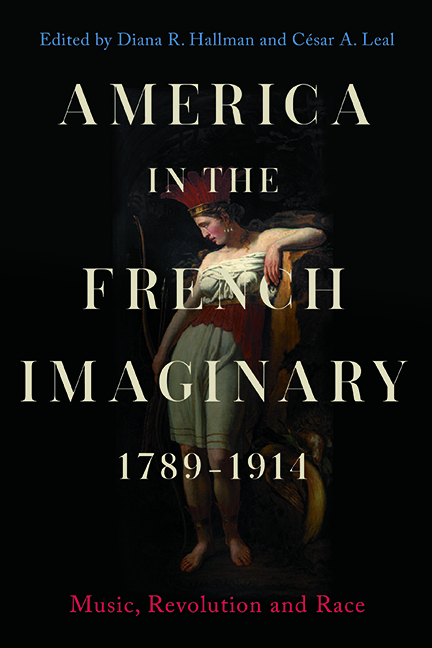Book contents
- Frontmatter
- Dedication
- Contents
- List of Illustrations
- List of Music Examples
- List of Abbreviations
- Editorial Notes
- List of Contributors
- Acknowledgements
- Preface
- Introduction
- Part I American liberté, sauvagerie and esclavage
- Part II Myths of America and Intersecting Identities
- Part III Soundscapes and Sonic Fantasies
- Part IV America, Commodification and Race at the fin de siècle
- Bibliography
- Index
- Music in Society and Culture
1 - Between Amérique and Colonial France: Revolutionary Tales of liberté and esclavage
Published online by Cambridge University Press: 15 September 2022
- Frontmatter
- Dedication
- Contents
- List of Illustrations
- List of Music Examples
- List of Abbreviations
- Editorial Notes
- List of Contributors
- Acknowledgements
- Preface
- Introduction
- Part I American liberté, sauvagerie and esclavage
- Part II Myths of America and Intersecting Identities
- Part III Soundscapes and Sonic Fantasies
- Part IV America, Commodification and Race at the fin de siècle
- Bibliography
- Index
- Music in Society and Culture
Summary
In French operas, dramas, and novels of the Revolutionary era and early decades of the nineteenth century, stories and images of America centred on themes inextricably linked in the history of both nations: those of liberté and esclavage. Representations of the American colonists’ struggle for freedom and portrayals of beloved American patriots and French soldiers who aided them mirrored France's own turbulent quest to construct a republic and transform its subjects into citoyens. As counterpoint to staged encomiums to American independence and democracy, French dramas that touched on the controversial subject of slavery cast light on practices that undermined fundamental principles of America's Declaration of Independence and France's Déclaration des droits de l’homme et du citoyen as they prolonged colonialist systems enabled by the monarchies that the Revolutions of 1776 and 1789 had overthrown. Theatrical as well as literary works joined in Revolutionary and post-Revolutionary abolitionist critiques that intimated comparisons between French and North American slavery practices, while simultaneously mitigating or validating them in France's American colonies. Theatrical slave narratives in island settings alluded to France's colonies of the West and East Indies as they highlighted the overcoming of slavery's harsh realities with utopian ideals of racial égalité and promises of liberté. Of particular interest to ideas of revolution are those whose plots and characters centre on a cataclysmic event of Caribbean Amérique: the slave insurrections of 1791–1804 in the French colony of Saint-Domingue, commonly known as the Haitian Revolution today.
In contrast to the American and French Revolutions, as the historian Jeremy Popkin underscores, the Saint-Domingue/Haitian Revolution ‘directly challenged the system of racial hierarchy’ that dominated the Atlantic world and starkly exposed the ‘incompatibility’ of slavery with the Franco-American ideals of liberté and égalité. Led by Toussaint Louverture (c.1743–1803) and other island leaders, who ‘deploy[ed] the language of Republican rights and the promise of individual liberty’, the Saint-Domingue Revolution ‘emerged symbiotically [with the French Revolution] as news, ideologies, and people crisscrossed the Atlantic’, as Laurent Dubois writes. The symbiosis encompassed the United States, with its shared ideological values and republican model, reinforced by the appearance of Franco-Caribbean news in metropolitan periodicals and Francophone communities.
- Type
- Chapter
- Information
- America in the French Imaginary, 1789-1914Music, Revolution and Race, pp. 15 - 49Publisher: Boydell & BrewerPrint publication year: 2022

